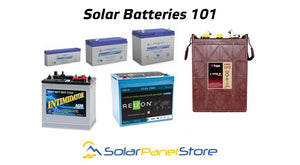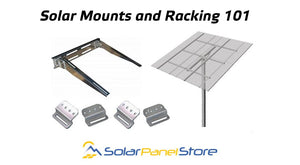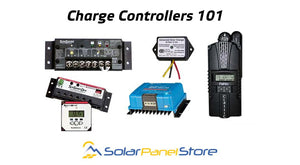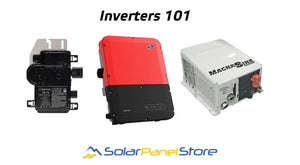Solar Panel Store Blog

Solar Batteries 101
Do I need solar batteries for my system?
Everyday we talk to customers looking to use solar energy to power all kinds of different things. For instance, if they want to simply reduce their electric bill from the local utility, then we're clearly looking at a "grid-tied" solar system. But often people want to power some type of device directly from a solar panel. Or they need mobile power, or power for something remote and away from electric utility lines, or back-up power. More often than not, this means batteries! And not just any batteries, but solar batteries (batteries suitable for solar systems).
Can't I just plug it directly into a solar panel?
Usually no. Most devices that need electricity require steady, reliable current (amps) and voltage to operate as designed. The voltage produced by a solar panel when it captures the sun's light varies constantly. Clouds, weather, and the changing position of the sun throughout the day are to blame. Also, solar panels only produce DC (direct current) electricity, which means it must be inverted to AC electricity by way of an "inverter". But an inverter requires steady, consistent energy as well. However, there are a few types of "loads" that can be powered directly from a solar panel. Certain types of attic fans or water pumps can operate effectively with the varying voltage throughout the day. But for most other loads, the DC energy from the solar panel must be first inverted to the proper form or stored in a solar battery system.
What what is a battery, really?
Putting solar aside, for a moment, we are all familiar with batteries. We use all kinds to power all kinds of devices. But at the end of the day, a battery is simply a device to store energy produced somewhere else at some other time. Like a water storage tank filled by a pump, a battery holds or stores a certain amount of energy.
How much depends on the battery's size, construction, type, chemistry, environment, etc. Unlike the throw-away AAAs in your TV remote, batteries used for solar energy systems big and small are rechargeable. A rechargeable battery can be discharged and recharged over and over again (one discharge and recharge is called a "cycle"). The battery's chemistry and type determine how deeply the battery can be discharged and the number of cycles it can perform during Its lifetime.
Batteries for Solar?
There are a number of factors to consider when buying solar batteries. Because the battery bank is one of the most expensive components of such a system, it is important to carefully design the battery bank so that it performs as expected for as many years as possible. When designing a battery bank we first analyze how the batteries will be used. How much energy must the battery bank supply to the “loads” each day? A load is any device that uses energy. People are often surprised when we ask them to list all of the loads they will use each day, the watts of each load and how many hours a day they expect to use them. But
that detailed info is needed to determine the daily watt-hours of storage which determines the battery bank size. From there we consider other factors to recommend the best battery bank for the specific situation.
Other factors
Because we're trying to keep this overview fairly basic, we will discuss factors like battery chemistry, sizes, capacity, and more in later blog posts. But we want to comment on just a couple more important points to keep in mind as you look for solar batteries.
Brands
There are quality long-lasting batteries and there are cheap short-lived batteries. We stick with quality brands. You can find cheap batteries all over the place. But if you want your batteries to last and give your solar system the most bang for the buck, it's usually worth it to get quality. We often supply quality brands that are not even on our site today, so please ask!
Deep Cycle
For solar systems, you want to stick to deep cycle batteries only. You don't want car or “starting” batteries for a solar system. If the battery doesn't list Amp Hours and instead only lists CCR (Cold Cranking Amps) then avoid it, even if the battery is labeled Deep Cycle. Deep cycle batteries are meant to slowly discharge down to a certain point and then recharge fully. And repeat that cycle over and over for many years. Car batteries are designed to a very different thing--quickly start a car engine in a short burst of current. Just remember deep cycle.
Capacity
Because solar battery systems store energy for gradual discharge (usually throughout the night), a good deep cycle battery will list its storage capacity in Amp Hours as measured over a 20 hour discharge rate (designated as "C/20"). Sometimes batteries will show different discharge rates (C/100, etc). Just make sure to use the C/20 rate to compare capacities among batteries. The more amp hours the better. Deep cycle batteries generally should not be discharged beyond 50% of its rated capacity. If they go beyond that level, the battery can be damaged and its ability to fully recharge will be reduced. For that reason, it's really important to size the battery bank correctly or else your battery life will be cut way short.
Voltage
If you are running an RV solar system, boat system, outdoor yard lights, water pump, remote instrumentation, etc., then chances are very good that you are operating equipment designed to run on 12 volts of DC electricity (sometimes designated VDC). So you will want to keep your battery bank at 12 volts. If you are powering a large off-grid home, then you'll want to be at 48 volts. Smaller cabins at 24 volts. We design battery banks to match these system voltages by using individual batteries that may be at 12 volts, 6 volts or 2 volts. Again, we'll get into the specifics in a future post, but for now that is why you'll see batteries with these different voltages listed on our site.
Chemistry
While there is a lot of hype today about lithium ion batteries, lead acid batteries still lead the way as the most economical, long-lasting battery for solar energy systems. For most people, lead acid batteries still make the most sense. But if the batteries need to be light, fully cycle daily, and at moderate temps, then lithium may be a great choice. If price isn't a big deal. But today, lithium prices are pretty high compared to lead acid.
Click here to see our lines of batteries for your application. Questions, just ask!
- Thomas Lindberg
- Tags: Batteries Solar Basics

Solar Mounts and Racking 101
To mount or not to mount? No, that's not really the question when it comes to solar panels. You pretty much have to secure them to something. The question is what solar mounting racks are available and how do you choose which one is right for you?
Type.
Solar panel type or construction will often drive your options for solar PV mounting structures. Most solar panels these days are rigid, aluminum-framed, tempered-glass covered silicon modules. These types of solar panels will mount differently than thin-filmed modules which may be comprised of semi-flexible, plastic sheets. Semi-flexible sheets can be glued to house roofs, RV roofs, boat decking, you name it. They can handle curved surfaces well, and it's always nice to minimize holes in a roof. If you're looking for a good adhesive, check out our Sikaflex sealant page. Whereas, rigid aluminum-framed modules are designed to be clamped down to rails using special hardware and racking equipment described below. Sometimes people will screw through the frames to secure modules to home-made racking or frames, but that method is more common for small backyard projects like pumps, etc.Roof.
Mounting solar panels to a residential or commercial roof is extremely common and a number of racking manufacturers offer solar panel mount solutions to fit most any type or pitch roof. From ballast systems for flat residential or commercial roofs, to specialized fittings for asphalt shingle, standing-seam metal or clay tile roofs there is a solution for you! While most roof racking involves securing an L-shaped "foot" to the roof surface, and securing horizontal "rails" to the feet, onto which solar panels are clamped, there also "rail-less" options as well. Rail-less essentially involve attaching a set of feet to the roof and then securing a panel to a set of feet without rails. Rail-less solar mounting racks are desired sometimes for aesthetics and for certain locations that make rails impractical. So should you mount solar panels to your roof? Roof mounting is a great option when space or sunny options are limited. And that's probably why most residential installations are roof-mounted. Not everyone has enough sunny yard space to make a ground mount possible or desirable. It also avoids the additional expense and effort to trench for longer conductor runs and set post or poles necessary when ground mounting. You’ll want or need (depending on your local building requirements) to inspect your roof’s structure engineering to confirm it can support a solar PV mounting structure. Also inspect your roof's condition and make any repairs before installing a solar array. Fire codes also often have set-back requirements to ensure the perimeter of the roof is accessible for firefighters.Ground.
Solar panel mounts for the ground arrays come in two flavors: fixed and "top-of-pole" mounts. Either offers some benefits over roof solar mounting racks. Panels mounted on the ground will be cooler than on a roof, which helps maximize voltage and energy production a bit. They are also more accessible should you have any issues--which is rare. And some mounting options allow you to adjust the tilt of the array as the seasons change. Ground mounts can be placed in optimal sun, tilt and orientation to generate the maximum energy. Contrast to roof mounts that are usually flush mounted to the roof's tilt and direction (which is usually not ideal). Both fixed and pole mounts will require trenching to run buried conductors, and digging proper foundations. A fixed mount system may be a little more manageable as a DIY project. And manufacturers like SnapNRack provide the design layout and parts akin to a tinker toy set! That said, a pole mount may ofter the benefit of adjustability. Pole mounts can also be combined with a "tracker" feature that rotates the array throughout the day to follow the sun. Trackers can generate a bit more energy production than a fixed array. But with low panel prices, we have found that the cost and maintenance (moving parts break) can be offset by just oversizing your array by a panel or two.RV & Boat
Mounting solar panels on an RV roof or boat roof or deck is usually a little different than for typical residential or commercial roofs, so we have a separate page for solar panel mounts for RVs on our site. We already discussed adhering semi-flexible panels above. Rigid solar panels are individually mounted to an RV or boat roof using a set of Z-brackets, or to a tilt-mount bracket or a set of corner molded brackets glue to the roof and in turn screw into the aluminum frames for a rock solid mount. We also have a nice Go Power Cable Entry Plate that mounts over the roof hole and neatly connects to all solar panel leads--nice and clean.Side-of-Pole.
There are many types of industrial, farm or other remote power installations where 1-2 panels need to be mounted near the remote equipment (like pumps, lights, sensors, monitors, other instruments). So our Side Of Pole page shows a variety of solar panel mounts that connect to an existing pole. Typically a battery box can be mounted on the same pole to house the battery, charge controller and wiring. Many of these solar mounting racks can also be screwed into a horizontal wall (like a shed for example) and can be tilted as well. Often the less expensive mounts work best for 36 cell, 12 volt panels. But there are options for the larger 60 cell panels as well.Mounts and Racking Products.
Check out our Solar Mounts and Racking. We'd be happy to help you find the specific mounting solution to fit your needs. Give us a call!- Thomas Lindberg
- Tags: Mounts Racking Solar Basics Solar Mounts and Racking

Charge Controllers 101
Do you need a solar charge controller?
If your solar PV system will require batteries, then YES! If not, you can skip right on by this page. Why? Because solar charge controllers control or regulate the charging of batteries in a battery-based solar PV system. And because most residential solar electric systems are “grid-tied” systems, they do not use batteries and thus have no need for solar panel controllers. But all the off-grid homes and remote equipment power by solar-charged battery systems (lights, sensors, instruments, etc.) need charge controllers to safely and efficiently charge their battery investments.
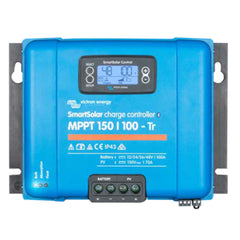
What do charge controllers do?
Didn't we just cover this? Kind of. But let's get a little more specific. You may wonder why these devices aren't just called battery chargers? Generally speaking, a battery charger refers to a device that you plug into an AC outlet and then connect to a battery to charge it. You may have one in your garage to charge the car battery when dead. A charge controller is used to regulate the voltage and current coming from a DC energy source like a solar PV array. It sometimes helps to think of these as solar charge controllers or DC charge controllers, especially if your system may also include an inverter/charger (mentioned on our Inverter page). In that case you would still need both the inverter/charger (which involves AC charging of the battery bank) and a DC solar charge controller to regulate the flow of solar DC energy into the batteries.Charge Controller - Water Faucet Analogy.
The goal in charging a battery is to bring the battery's voltage up to a factory-defined level that represents its full charge. A classic analogy will illustrate how solar charge controllers work. Imagine you want to fill a glass from a water faucet. Think of the faucet as the charge controller and the glass as the battery. The water level in the glass represents the battery's voltage level. The water flow represents the current. As long as the water level is low enough, and the flow of water slow enough, then the glass will accept more water. Just like a low battery will accept DC current. But turning the faucet wide-open will quickly overflow the glass from the force of the water flow. Similarly, without a charge controller, excessive DC current flow can overcharge the battery. But adjusting the faucet, reduces the water flow to more steadily fill the glass without spillage. Likewise, a charge controller controls regulates the DC current flowing into the battery to steadily raise the battery's voltage to effectively and efficiently re-charge the battery without causing damage.Battery Charging Set points.
More specifically, a charge controller regulates current into the battery by based on charging "set points" for that battery. Battery manufacturers specify certain voltage levels ("set points") for each of the 3 stages of battery charging. There is a set point for the bulk, absorption and float charge stages that solar panel controllers keep track of. So a depleted battery is like that empty glass. The charge controller feeds the the highest current (like the fast water flow of an open faucet into an empty glass) during the bulk stage until the voltage level rises to the bulk stage set point at which point the battery is about 80% recharged. At that point, the charge controller reduces current (or flow) like a slow-running faucet until it reaches the absorption set point. After that the charge controller basically just drips enough current to keep the battery voltage at its float set point (filled to the brim).What kind do I need?
There are two types of charge controller technology used these days. The cheaper, effective but more limited PWM or pulse width modulation charge controllers are one type. While MPPT or (maximum power point tracking) charge controllers are the more efficient and flexible, but more expensive type. On our website, you'll find PWM charge controllers under the Small Charge Controller page, but you'll find MPPT charge controllers on both the Small Charge Controller and Large Charge Controller pages. We define Small Charge Controllers to generally be those up to 30 Amps, and Large Controllers above that.
PWM Charge Controllers.
In the typical scenario, we look to see if we can simply match the voltage of the controller to your battery bank. So a 12 volt controller matches with a 12 volt battery bank/system. This is the typical situation with an RV or boat. Similarly, if you have a 24 volt battery bank for your off-grid house, you would match it with a 24 volt charge controller. Same for 48 volt systems. In these scenarios, the cheaper and perfectly good choice would be a pulse width modulation (PWM) solar panel controller. Huh? We'll explain in a minute. Contrast the PWM controller with a maximum power point tracking (MPPT) charge controller. The MPPT controllers cost more, but allow you to use a larger voltage solar panel/array with a smaller voltage battery system. So a 60 cell, 30V solar panel can charge a 12 volt battery bank when an MPPT controller is used.MPPT Charge Controllers.
An MPPT charge controller feeds the maximum amount of energy produced by the solar array to the battery bank. Voltage may vary from the solar array depending on the sun's intensity. But despite that, an MPPT charge controller can use all of the available energy to charge the batteries Why? Since watts = voltage x current, an MPPT controller can adjust the voltage to match the battery by adjusting the current. This also allows an MPPT controller to use a larger voltage solar array than the battery bank uses. So while the MPPT controllers cost more, they get more charging bang, for the solar array buck. Conversely, a PWM charge controller can only use the voltage supplied by the solar array that matches the battery bank voltage to charge the battery bank . So when panels produce more voltage in better sun and/or cooler temps, the PWM controller can only use up to its rated voltage to charge the batteries--which may mean energy wasted. Similarly, a PWM controller cannot use a higher voltage solar array (say 30 volts) to charge a 12 volt battery bank. But a PWM does a very nice job charging batteries if its voltage is in sync with the battery bank. In the same way pulsing a faucet on and off in quick small bursts get a glass of water nicely full, a PWM controller charges a battery by pulsing quick small bursts of solar energy.
Click here to see our charge controller product lines or drill down into specific types in the menu above.
- Thomas Lindberg
- Tags: charge controllers Solar Basics

Inverters 101
Solar Inverters.
What is an inverter?
Grid-direct inverter.
Stand-alone, off-grid inverter.
Grid-Tied with Battery Back-up.
String vs Module level inverters.
String inverters.
Microinverters.
DC Optimizers.
Solar Inverter Pages.
- Thomas Lindberg
- Tags: Inverters Solar Basics

